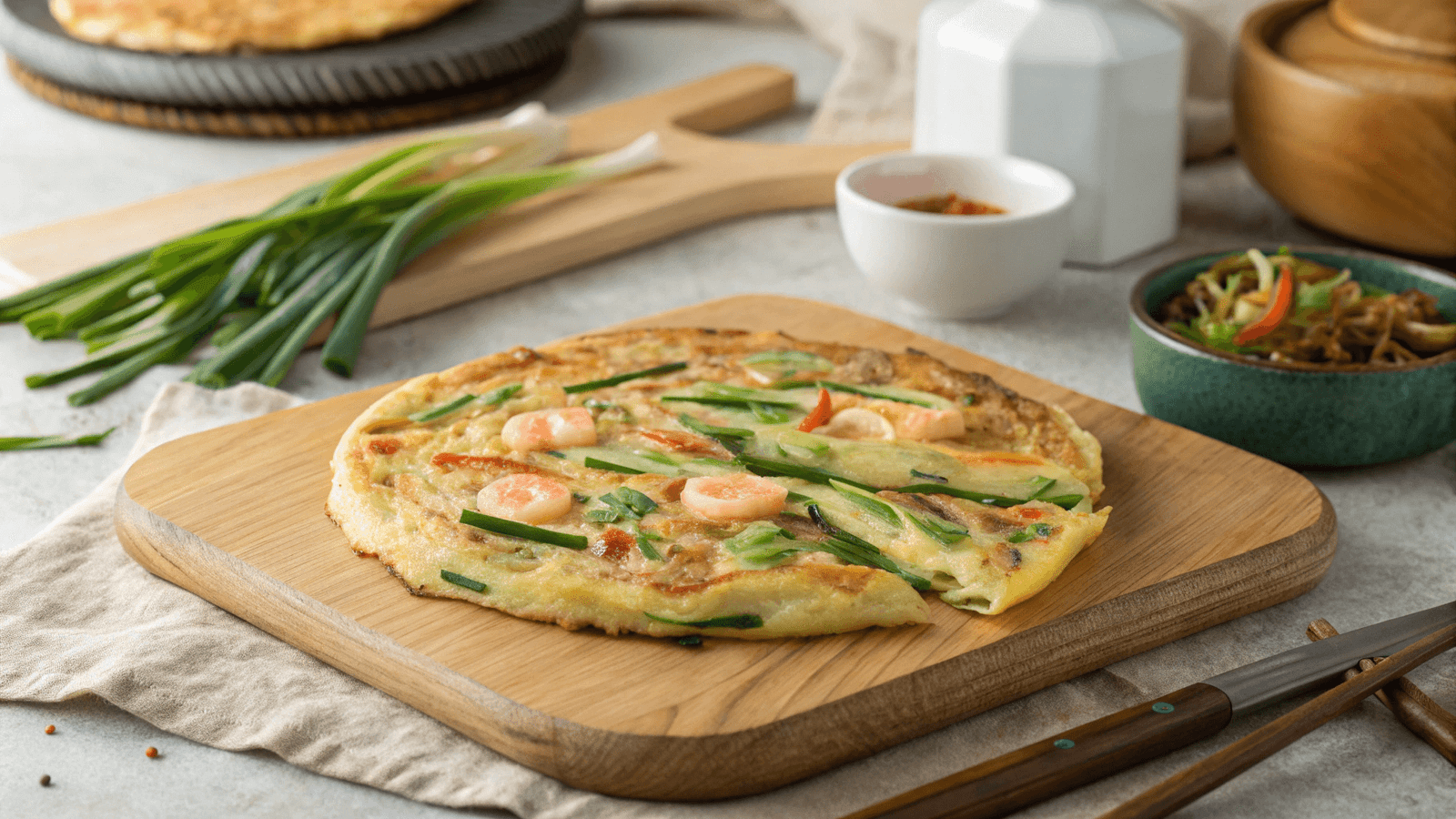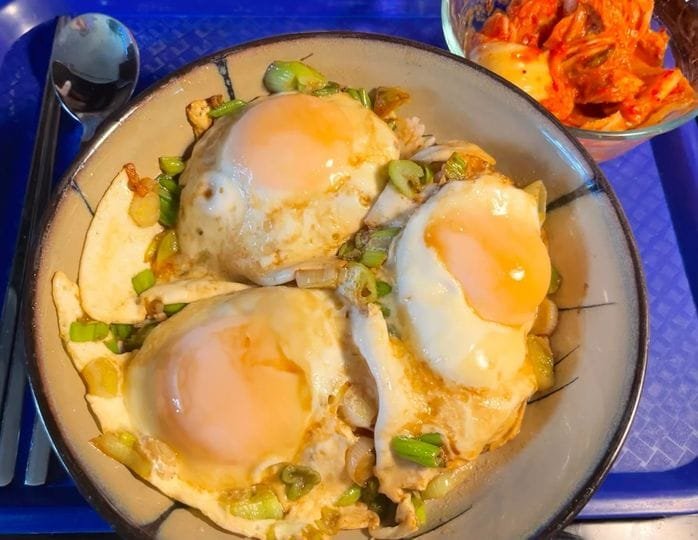7 Tips for Making the Perfect Korean Vegetable Pancake at Home
(Crispy, savory, and healthy! Learn to make the perfect Korean Vegetable Pancake (Yachaejeon) at home with these 7 essential tips.)
Table of Contents
Making Korean Vegetable Pancakes, or Yachaejeon, is a rewarding experience. It’s a dish that’s incredibly versatile. You can serve it as a snack, an appetizer, a side dish, or even a light meal. However, creating that perfect balance of crispy and tender can be tricky. Therefore, I’m sharing seven expert tips to guide you in your Yachaejeon journey. These tips will help you achieve the perfect balance of flavor and texture.
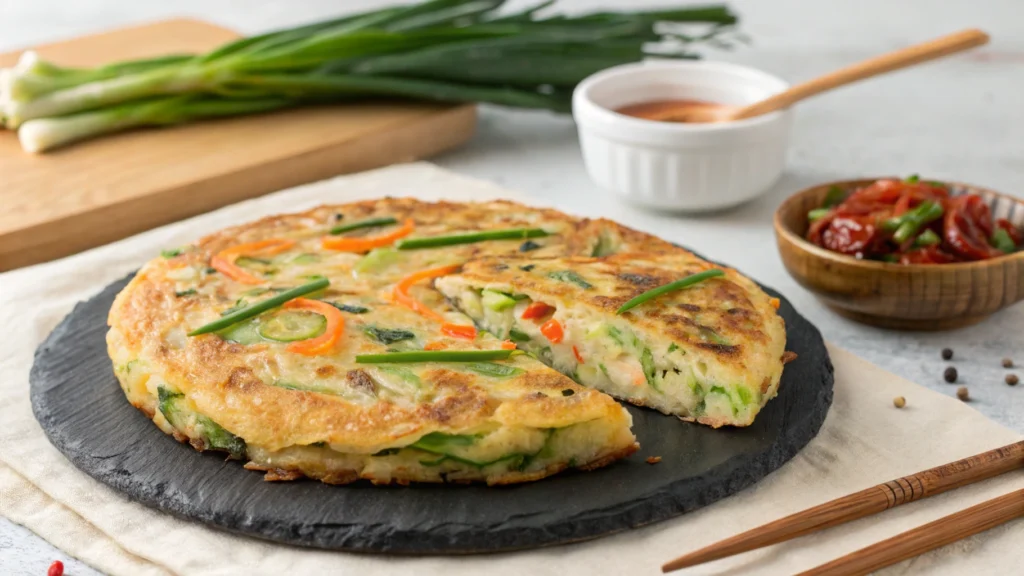
Understanding Yachaejeon: Your Key to Success
Yachaejeon (야채전), literally “vegetable pancake,” is a savory Korean pancake made primarily with vegetables. It’s a staple in Korean cuisine and is often enjoyed during rainy days. Indeed, the sizzling sound of the pancake frying in the pan is said to mimic the sound of raindrops. While green onions, carrots, zucchini, and onions are classic ingredients, regional variations and personal preferences allow for countless combinations.
What Makes the Perfect Yachaejeon?
A truly perfect Yachaejeon boasts several key characteristics:
- Crispy Exterior: The first bite should offer a satisfying crunch. A crispy exterior is crucial.
- Tender Interior: However, underneath that crispiness, the inside should be tender and cooked through, not doughy.
- Flavorful Vegetables: Furthermore, the vegetables should be fresh and contribute a burst of savory flavor.
- Balanced Batter: The batter is the glue that holds everything together. Therefore, it needs to be just right – not too thick, not too thin.
This recipe and the tips that follow matter because they address the common pitfalls that many home cooks face. For example, a soggy pancake, a bland taste, or a batter that’s difficult to work with. Thus, these tips will help you avoid these issues and create Yachaejeon that’s truly exceptional.
Tip #1: Master the Batter for Perfect Vegetable Pancake
The batter is the foundation of your Yachaejeon. Therefore, getting the consistency right is essential for achieving that coveted crispy-tender texture. The ratio of flour to water is the first key element to consider for the right batter for the perfect vegetable pancake.
The Importance of Batter Consistency for Yachaejeon
The batter consistency is arguably the most important factor in determining the final texture of your Yachaejeon. If the batter is too thick, the pancake will be dense and doughy. On the other hand, if the batter is too thin, the pancake will be greasy and prone to falling apart.
Finding the Ideal Flour-to-Water Ratio
A good starting point is a ratio of 1 cup of flour to ¾ cup of water. However, keep in mind that this may vary depending on the type of flour you use and the moisture content of your vegetables.
There are three main types of flour that are commonly used in Yachaejeon:
- All-Purpose Flour: This is the most readily available option, and works well.
- Korean Pancake Mix (Buchim Garu): For instance, this mix typically contains pre-mixed seasonings and produces a slightly chewier texture.
- Rice Flour: Therefore, using rice flour creates a crispier and lighter pancake, but it can also make the pancake more fragile.
It’s important to note that Korean pancake mix already contains seasonings. If you’re using all-purpose flour, however, you’ll need to add salt, pepper, and other seasonings to taste.
The Role of Eggs in a Great Yachaejeon Recipe
Eggs act as a binding agent in the batter, helping to hold the ingredients together. Furthermore, they add richness and contribute to a slightly softer texture. However, eggs aren’t always necessary. If you’re vegan or have egg allergies, you can easily omit them or use a vegan egg substitute.
Achieving the Right Batter Texture
The ideal batter texture is similar to a thin crepe batter. Importantly, it shouldn’t be perfectly smooth. In fact, a slightly lumpy batter is preferable. This prevents the development of gluten, which can make the pancake tough. To achieve this, mix the batter minimally, just until the ingredients are combined.
Resting the Batter (Optional)
Resting the batter for 15-20 minutes can allow the flour to fully hydrate and the gluten to relax. However, this can also result in a slightly chewier pancake. Therefore, whether or not to rest the batter is a matter of personal preference. Try both ways and see which you prefer.
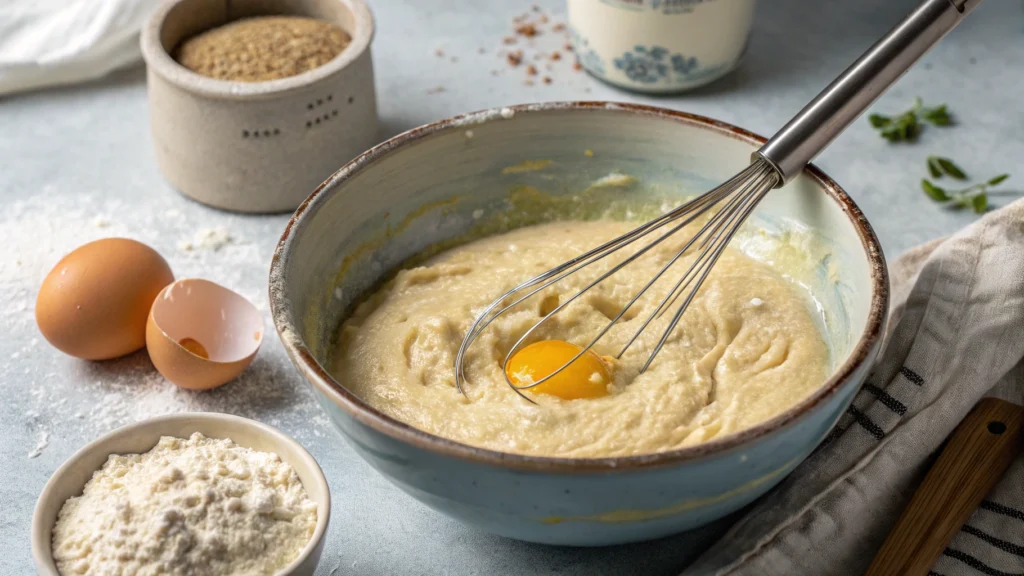
Tip #2: Choosing and Preparing the Best Vegetables for Your Korean Pancake
The quality and preparation of your vegetables are just as important as the batter. Therefore, selecting fresh, in-season produce and preparing it properly is key to creating a delicious and flavorful Yachaejeon.
Prioritize Freshness and Quality for Vegetable Pancake
The fresher the vegetables, the better your Yachaejeon will taste. Therefore, choose vegetables that are firm, vibrant in color, and free from blemishes.
Essential Vegetable Ingredients for Korean Pancakes
Here are some of the most common and essential vegetables used in Yachaejeon:
- Green Onions: Scallions, also known as green onions, add a pungent and slightly sweet flavor. However, use both the white and green parts for maximum flavor.
- Carrots: Julienned carrots provide a touch of sweetness and color. Ensure that they are julienned thinly and evenly for uniform cooking.
- Zucchini: Zucchini adds a mild, slightly sweet flavor and a tender texture. However, it can also release a lot of moisture. Therefore, it’s essential to remove excess moisture before adding it to the batter.
- Onions: Onions add a savory depth of flavor. Different types of onions, such as yellow, white, or red, will impart slightly different flavors.
- Bell Peppers: Bell peppers add sweetness, color, and a slight crunch. Color variations such as red, yellow, and orange, can add a lot of visual appeal.
Preparing Vegetables for Perfect Vegetable Pancake
The key to properly preparing the vegetables is to cut them into uniform sizes. This ensures that they cook evenly.
- Julienning: Julienning is a technique for cutting vegetables into thin, matchstick-like strips. For example, this is ideal for carrots and bell peppers.
- Slicing: Slicing is simply cutting vegetables into thin rounds or half-moons. For instance, this works well for onions and zucchini.
To prevent excess moisture in the Yachaejeon, especially from vegetables like zucchini and onions, sprinkle them with salt and let them sit for 10-15 minutes. Afterward, squeeze out the excess water with your hands or a clean kitchen towel.
Getting Creative with Vegetable Combinations
Don’t be afraid to experiment with different vegetable combinations. For example, you can add mushrooms for an earthy flavor, spinach for a boost of nutrients, or bean sprouts for added crunch. Consider flavor pairings such as: zucchini and corn, or carrots and mushrooms.

Tip #3: Enhance the Flavor with Seasoning for Korean Pancakes
Seasoning is what elevates Yachaejeon from bland to brilliant. Therefore, don’t underestimate the power of a well-seasoned batter and vegetables.
The Importance of Seasoning Yachaejeon
A bland batter and unseasoned vegetables will inevitably result in a bland pancake. Therefore, take the time to properly season both the batter and the vegetables.
Essential Seasonings for Korean Pancakes
These are some of the essential seasonings to have on hand:
- Salt: Salt enhances the flavors of the vegetables and balances the sweetness. However, use sea salt or kosher salt.
- Pepper: Freshly ground black pepper adds a subtle warmth and complexity.
- Garlic: Freshly minced garlic provides a pungent and aromatic flavor.
- Soy Sauce: Soy sauce adds umami and saltiness. Also, choose light soy sauce for a brighter flavor or dark soy sauce for a richer, more intense flavor.
- Sesame Oil: A drizzle of sesame oil adds a nutty and aromatic fragrance.
Seasoning Strategy: Batter or Vegetables?
You can choose to season the batter, the vegetables, or both. Seasoning both, however, will result in a more intensely flavored pancake.
Korean Flavor Boosters for Vegetable Pancakes
Consider adding these Korean flavor boosters for a more authentic taste:
- Gochugaru (Korean Chili Powder): Adds a subtle kick of heat.
- Dashima (Kelp) Powder: Infuses the pancake with umami.
- Anchovy Powder: Another umami option for a savory depth.
Always taste the batter and vegetables before cooking and adjust the seasoning as needed. However, don’t be afraid to experiment with different combinations and amounts to find what you like best.
Tip #4: Choose the Right Pan and Oil for Crispy Yachaejeon
The right pan and oil are crucial for achieving that desirable crispy exterior without burning the pancake.
Pan Materials for Cooking Vegetable Pancake
Consider these pan materials to cook your pancake:
- Cast Iron: Distributes heat evenly and retains heat well, resulting in a crispy crust. However, it can be heavy and requires proper seasoning.
- Non-Stick: Easier to use and clean, but may not produce as crispy of a crust.
Pan size is also important. A 10-12 inch pan is ideal for making one large pancake. A heavy-bottomed pan ensures even heat distribution.
Best Oils to Use for Yachaejeon
Choose an oil with a high smoke point to prevent burning:
- Vegetable Oil: Neutral flavor and high smoke point.
- Canola Oil: Similar to vegetable oil.
- Grapeseed Oil: Another good option with a neutral flavor.
- Sesame Oil: Use sparingly for flavor, as it has a lower smoke point.
Avoid olive oil, as it has a lower smoke point and can burn easily.
Pan Preheating for Great Yachaejeon
A properly preheated pan is essential for achieving a crispy crust. Therefore, heat the pan over medium heat for several minutes until it’s hot enough. You can test if the pan is hot enough by flicking a few drops of water into the pan. If the water sizzles and evaporates immediately, the pan is ready.
Using the Right Amount of Oil
Use a generous amount of oil to ensure that the pancake doesn’t stick and that it develops a crispy crust. However, swirl the oil around the pan to coat it evenly. If the pan gets too dry during cooking, add more oil.
Tip #5: Master the Technique for Evenly Cooked Korean Pancakes
Knowing how to cook your Yachaejeon makes all the difference for a satisfying dish.
Pouring the Batter into the Pan
Pour the batter evenly into the preheated pan, using a ladle or measuring cup. Spread the vegetables evenly throughout the batter. You can either fill the entire pan for one large pancake or make smaller individual pancakes.
Maintaining Medium Heat
Cook the pancake over medium heat. This allows the pancake to cook through without burning. Adjust the heat as needed to maintain a consistent temperature.
The Art of Flipping the Pancake
The flip is one of the most critical steps. Therefore, wait until the edges of the pancake are golden brown and the bottom is set before attempting to flip it. Use a spatula or two to carefully flip the pancake. If the pancake breaks during flipping, don’t worry! Simply press the pieces back together with a spatula.
Ensuring Even Cooking
Press down on the pancake with a spatula to ensure even contact with the pan. Also, rotate the pan occasionally to ensure even heat distribution.
Knowing When the Pancake is Done
The pancake is done when both sides are golden brown and crispy, and the batter is set and no longer runny.
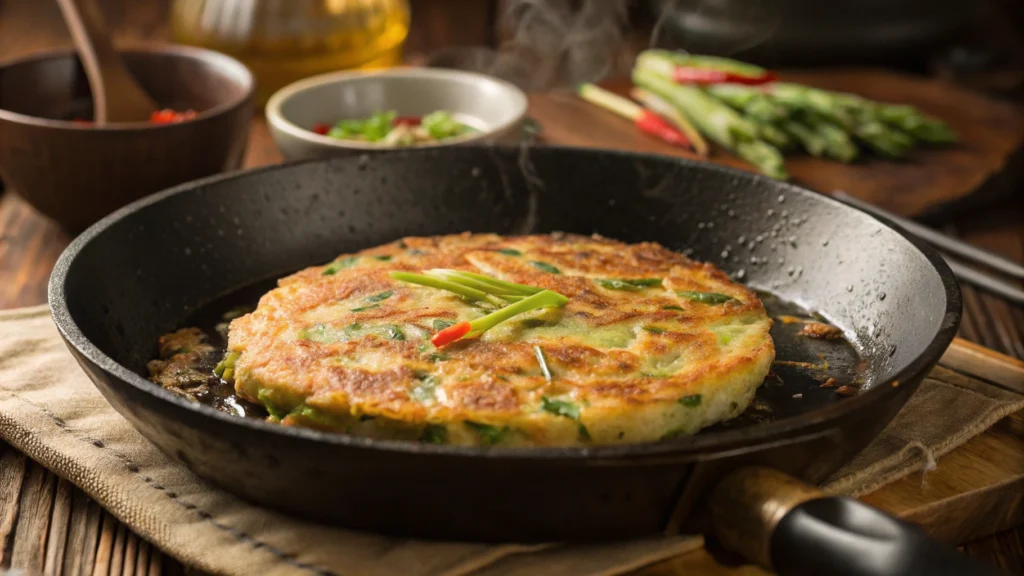
Tip #6: Create the Perfect Dipping Sauce for Yachaejeon
The dipping sauce is the perfect complement to the savory flavors of the Yachaejeon. It adds a touch of acidity, sweetness, and heat.
Key Ingredients for a Great Dipping Sauce
Here are some of the classic dipping sauce ingredients:
- Soy Sauce: The base of the sauce.
- Rice Vinegar: Adds tanginess and balances the flavors.
- Sesame Oil: Provides aroma and richness.
- Gochugaru: (Optional) For a spicy kick.
- Sugar or Honey: To balance the flavors.
Dipping Sauce Variations to Serve With Korean Pancakes
Here are some creative variations on the classic sauce:
- Add chopped green onions or sesame seeds for added flavor and texture.
- Use lemon juice instead of rice vinegar for a brighter flavor.
- Include a touch of minced garlic for a more pungent flavor.
Beyond the soy sauce, other options include gochujang-based sauces, ssamjang, or even wasabi mayo.
Serving Your Homemade Dipping Sauce
Serve the dipping sauce in small individual bowls for dipping or in a larger bowl for sharing.
Tip #7: Serving and Storing Yachaejeon
Yachaejeon is best enjoyed fresh. Follow the tips below to best serve the dish you worked so hard on.
The Best Way to Serve Korean Pancake
Yachaejeon is best enjoyed immediately while it’s still hot and crispy.
- Garnish with chopped green onions or sesame seeds for added flavor and visual appeal.
- Serve as an appetizer or snack.
- Enjoy as a side dish to Korean BBQ or other Korean meals.
- Have it as a light lunch or dinner.
Properly Storing Leftover Yachaejeon
Allow the pancakes to cool completely before storing them. Then, store them in an airtight container in the refrigerator for 1-2 days.
Reheating Methods
- Pan-Frying: This is the best method for restoring crispiness. Reheat the pancakes in a lightly oiled pan over medium heat until heated through and crispy.
- Oven: This is a good option for reheating larger quantities. Preheat the oven to 350°F (175°C) and reheat the pancakes on a baking sheet for 10-15 minutes.
- Microwave: This is the least desirable method, as it can make the pancakes soggy. However, it’s acceptable for a quick reheat.
Troubleshooting Common Korean Pancake Problems
Even with the best intentions, you might encounter some issues along the way. But, don’t worry, here are some common problems and how to fix them.
Soggy Korean Pancake?
This may be due to too much moisture in the vegetables, the pan not being hot enough, or not enough oil.
Pancake is Burning?
Reduce the heat, or the pan might be too hot.
Pancake is Falling Apart?
The batter might be too thin, or there is not enough binding agent (egg).
Pancake is Bland?
Make sure to use sufficient seasoning.
Recipe for Perfect Korean Vegetable Pancake (Yachaejeon)
Yields: 2-3 pancakes
Prep time: 20 minutes
Cook time: 20 minutes
Ingredients:
- 1 cup all-purpose flour (or Korean pancake mix)
- ¾ cup cold water
- 1 large egg (optional)
- ½ teaspoon salt
- ¼ teaspoon black pepper
- 1 tablespoon vegetable oil, plus more for frying
- 1 cup mixed vegetables, julienned (carrots, zucchini, onions, green onions)
Dipping Sauce:
- 2 tablespoons soy sauce
- 1 tablespoon rice vinegar
- 1 teaspoon sesame oil
- ½ teaspoon sugar or honey
- ¼ teaspoon gochugaru (optional)
Instructions:
- Prepare the Vegetables: Wash and julienne all vegetables. If using zucchini or onions, sprinkle with a pinch of salt, let sit for 10 minutes, and squeeze out excess moisture.
- Make the Batter: In a large bowl, whisk together flour, water, egg (if using), salt, and pepper until just combined. It’s okay if the batter is slightly lumpy.
- Combine Vegetables and Batter: Gently fold the julienned vegetables into the batter.
- Prepare Dipping Sauce: In a small bowl, whisk together soy sauce, rice vinegar, sesame oil, sugar or honey, and gochugaru (if using).
- Heat the Pan: Heat a large skillet or cast-iron pan over medium heat. Add 1-2 tablespoons of vegetable oil.
- Cook the Pancakes: Pour ½ – 1 cup of batter into the hot pan, spreading it out evenly with a spatula.
- Cook the First Side: Cook for 3-5 minutes, or until the bottom is golden brown and crispy.
- Flip and Cook the Second Side: Carefully flip the pancake with a spatula and cook for another 3-5 minutes, or until the second side is golden brown and crispy.
- Serve: Remove the pancake from the pan and place it on a cutting board. Cut into wedges and serve immediately with the dipping sauce.
Nutritional Information
Nutritional Content (Per 100g)
| Nutrient | Amount |
| Calories | 150 |
| Total Fat | 8g |
| Saturated Fat | 1g |
| Cholesterol | 20mg |
| Sodium | 250mg |
| Total Carbohydrate | 18g |
| Dietary Fiber | 2g |
| Sugar | 2g |
| Protein | 3g |
Enjoy your delicious, homemade Yachaejeon!
Frequently Asked Questions (FAQs)
Here are some frequently asked questions about making Korean Vegetable Pancakes:
What’s the best Korean pancake recipe?
The best Korean pancake recipe balances crispy edges with a tender interior. It starts with a batter made from flour, water, and optional egg, combined with a variety of fresh, julienned vegetables. Seasoning is key.
What is Yachaejeon?
Yachaejeon is a savory Korean pancake made primarily with vegetables. It’s a popular dish that’s often enjoyed as a snack, appetizer, or light meal.
Can I make Korean pancakes sweet?
While traditionally savory, you can add a touch of sweetness by including vegetables like sweet potatoes or corn in your Yachaejeon. However, keep in mind that the dominant flavor should still be savory.
What is the best Pajeon recipe?
Pajeon is a type of Korean pancake made primarily with green onions. The best Pajeon recipe uses a similar batter to Yachaejeon, but with a generous amount of green onions as the star ingredient.
Can I add seafood to my Korean pancake?
Yes, you can definitely add seafood to your Korean pancake. Squid, shrimp, and clams are popular choices that add a delicious savory flavor.
Is there a Chickpea flour Korean pancake recipe?
Yes, you can use chickpea flour as a gluten-free alternative to all-purpose flour in Korean pancakes. However, you may need to adjust the amount of water to achieve the right batter consistency.
What’s the best Korean pancake sauce?
The best Korean pancake sauce is a balanced combination of soy sauce, rice vinegar, sesame oil, sugar, and gochugaru (optional). Adjust the ratios to your preference for sweetness, tanginess, and spice.
Is there a Marion Grasby Korean pancake recipe?
Marion Grasby is a well-known food writer with many delicious Korean-inspired recipes. It is recommended that you search online for a recipe specifically created by her. Her creations usually feature a fusion-inspired take on this Korean classic.
Conclusion
Making the perfect Yachaejeon at home is easier than you think. Furthermore, by mastering the batter, choosing the right vegetables, seasoning properly, using the right pan and oil, perfecting your cooking technique, creating a delicious dipping sauce, and serving it fresh, you can create Yachaejeon that rivals your favorite Korean restaurant. Therefore, try these tips and enjoy the process of creating this delicious and versatile dish!
Cooking is an act of love and creativity! 🌟 What do you think of this recipe? I’d love to hear your thoughts and any tips or tweaks you’d suggest to make it even better. Let’s inspire each other in the kitchen!
There are no reviews yet. Be the first one to write one.


